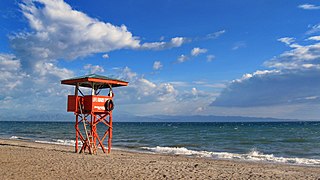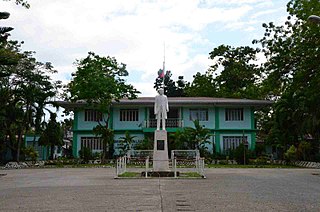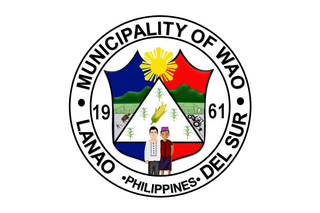
Sarangani, officially the Province of Sarangani, is a province in the Philippines located in the Soccsksargen region. Its capital is Alabel while Glan is the most populous municipality in the province. With a 230-kilometer (140 mi) coastline along the Sarangani Bay and Celebes Sea, the province is at the southernmost tip of Mindanao island, and borders South Cotabato and Davao del Sur to the north, Davao Occidental to the east, and the Celebes Sea to the south.

Soccsksargen, formerly known as Central Mindanao, is an administrative region of the Philippines, designated as Region XII. Located in south-central Mindanao, its name is an acronym that stands for the region's four provinces and one highly urbanized city. The regional center is in Koronadal, located in the province of Cotabato del Sur, and the center of commerce and industry is General Santos, which is the most populous city in the region.

Malaybalay, officially the City of Malaybalay, is a 1st class component city and capital of the province of Bukidnon, Philippines. According to the 2020 census, it has a population of 190,712 people.

Maitum, officially the Municipality of Maitum, is a 2nd class municipality in the province of Sarangani, Philippines. According to the 2020 census, it has a population of 44,185 people, making it the least populated municipality in the province.

Alabel, officially the Municipality of Alabel, is a 1st class municipality and capital of the province of Sarangani, Philippines. According to the 2020 census, it has a population of 88,294 people.

Maguindanaon, or Magindanawn is an Austronesian language spoken by Maguindanaon people who form majority of the population of eponymous provinces of Maguindanao del Norte and Maguindanao del Sur in the Philippines. It is also spoken by sizable minorities in different parts of Mindanao such as the cities of Zamboanga, Davao, and General Santos, and the provinces of North Cotabato, Sultan Kudarat, South Cotabato, Sarangani, Zamboanga del Sur, Zamboanga Sibugay, Davao del Sur, as well as Metro Manila. As of 2020, the language is ranked to be the ninth leading language spoken at home in the Philippines with only 365,032 households still speaking the language.

Wao officially the Municipality of Wao, is a 2nd class municipality in the province of Lanao del Sur, Philippines. According to the 2020 census, it has a population of 50,366 people. Wao is the only Christian-majority municipality of its province.

Valencia, officially the City of Valencia, is a 1st class component city in the province of Bukidnon, Philippines. According to the 2020 census, it has a population of 216,546 people. The city is applying for a Highly Urbanized City (HUC).

Sumilao, officially the Municipality of Sumilao, is a 4th class municipality in the province of Bukidnon, Philippines. According to the 2020 census, it has a population of 29,531 people.

The Lumad are a group of Austronesian indigenous peoples in the southern Philippines. It is a Cebuano term meaning "native" or "indigenous". The term is short for Katawhang Lumad, the autonym officially adopted by the delegates of the Lumad Mindanao Peoples Federation (LMPF) founding assembly on 26 June 1986 at the Guadalupe Formation Center, Balindog, Kidapawan, Cotabato. Usage of the term was accepted in Philippine jurisprudence when President Corazon Aquino signed into law Republic Act 6734, where the word was used in Art. XIII sec. 8(2) to distinguish Lumad ethnic communities from the islands of Mindanao.

The Pan-Philippine Highway, also known as the Maharlika Highway, is a network of roads, expressways, bridges, and ferry services that connect the islands of Luzon, Samar, Leyte, and Mindanao in the Philippines, serving as the country's principal transport backbone. Measuring 3,379.73 kilometers (2,100.07 mi) long excluding sea routes not counted by highway milestones, it is the longest road in the Philippines that forms the country's north–south backbone component of National Route 1 (N1) of the Philippine highway network. The entire highway is designated as Asian Highway 26 (AH26) of the Asian Highway Network.

The Manobo languages are a group of languages spoken in the Philippines. Their speakers are primarily located around Northern Mindanao, Central Mindanao and Caraga regions where they are natively spoken. Some outlying groups make Manobo geographically discontiguous as other speakers can be located as far as the southern peninsula of Davao Oriental, most of Davao Occidental and coastal areas of Sultan Kudarat. The Kagayanen speakers are the most extremely remote and can be found in certain portions of Palawan.
Sarangani is a Manobo language of the Davao Region of Mindanao in the Philippines.

The United Nationalist Alliance is a political party in the Philippines. It was created as a multi-party electoral alliance replacing the former United Opposition (UNO) coalition for the 2013 midterm elections, before it was launched as a single political party on July 1, 2015, by Jejomar Binay for his candidacy in the 2016 presidential election.
DXSG, broadcasting as 101.3 Radyo Natin, is a radio station owned and operated by Manila Broadcasting Company. Its studios and transmitter are located along Dela Cruz St., Brgy. Poblacion, Kiamba, Sarangani.

Cotabato, also known as the Province of Cotabato, was a historical province of the Philippines established in 1914 that existed until its dissolution in 1973. The province's capital from 1920 to 1967 was Cotabato City while Pagalungan became its capital from 1967 to 1973.
These are term limited and retiring members of the House of Representatives of the Philippines during the 16th Congress of the Philippines. Term limited members are prohibited from running in the 2016 elections; they may run for any other positions, or may wait until the 2016 elections.

National Route 1 (N1) is a primary national route that forms part of the Philippine highway network, running from Luzon to Mindanao. Except for a 19-kilometer (12 mi) gap in Metro Manila and ferry connections, the highway is generally continuous. Most sections of N1 forms the Pan-Philippine Highway except for sections bypassed by expressways.
The COVID-19 pandemic in Northern Mindanao is part of the worldwide pandemic of coronavirus disease 2019 caused by severe acute respiratory syndrome coronavirus 2. The virus reached Northern Mindanao on March 11, 2020, when the first case of the disease was confirmed in Cagayan de Oro.
These are term limited and retiring members of the House of Representatives of the Philippines during the 18th Congress of the Philippines, who cannot or would not run in the 2022 elections.














